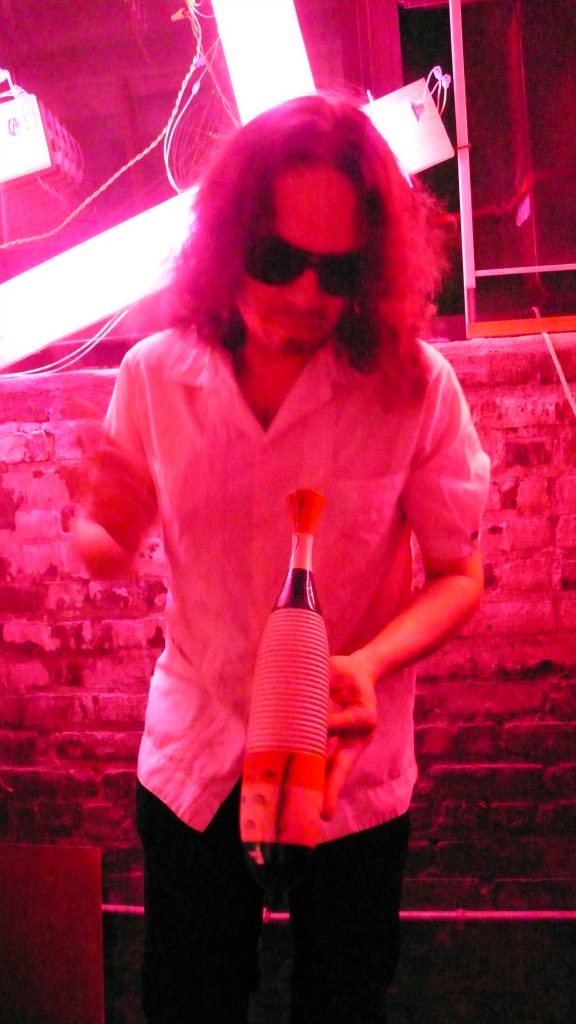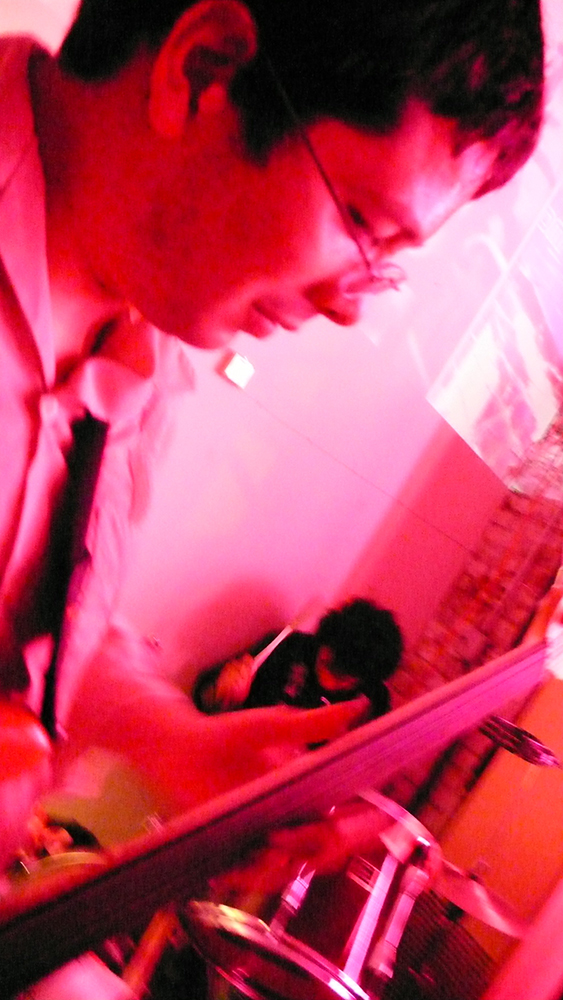Bachelor Sound Machín was the grouping of creators of diverse specialties who shared music preferences and a geographic location, which resulted in their manifestation as a collective to consolidate projects including the production of music, visual arts (installation, sculpture, photography and video), films and literature.
It all started with an ‘electric’ (converted using a pickup) jarana (Mexican small guitar) which allowed the use of a rudimentary distortion pedal called Big Muff -which required ‘shutting its mouth’ with pink electric gaffer tape to avoid contamination once amplified. This travestied jarocho instrument gathered for Mexicans in New York. José Luis Cortés and Alejandro Almanza, both plastic artists; René Peñaloza, filmmaker; and Miguel Medrano, Consulate lawyer, with a bass player calling. United by a marked taste for Veracruzan sounds, we decided to create a grouping to combine the tradition and rhythm of the Son Jarocho with the characteristic ease of some types of rock such as punk and garage.

Alejandro Almanza
Like all Son Jarocho fans, we were conscious that its execution requires a high dose of virtuosity -so we decided to mix it with the “do-it-yourself” spirit (DIY, so common in the USA) of the most rudimentary rock. The power of the band would then need to be based on the originality of the offer. We soon realized that multiple contact points existed between the Son Jarocho and Rock: the strong attack on guitars, dramatic volume variations and a full irreverence in the lyrics. In theory, all this made sense, since the Son shares the African and creole origins of blues, but in practice the compatibility was more immediate: the electroacoustic travestied jarana was as willing to give a rock twist to the Son -through the celebrated Big Muff pedal- as to give a jarocho twist to our most rocker repertory. The only thing lacking was giving a name to the project. Emphasizing its conceptual nature, we decided to name it Bachelor Sound Machin as a tribute to Marcel DuChamp, whose “Vidrio Grande” (Large Glass) was originally called ‘Bachelor Machine’.
The four of us had grown up during the nineties and found a common language in our taste for some sort of post cultural blend -expressed in a vein extending from the Xochimilcas, passing through the Tepetatles, Botellita de Jerez and Café Tacvba, to branches ending-up in post national groupings such as Cornershop or Plastilina Mosh. We also share a taste for Mexican science fiction such as the Santo or Chano Urrutia films; we seeded to cultivate a clearly Mexican futurist aesthetic which mixed sensibilities such as Sun Ra’s afro-futurism and Kraftwerk’s “motorik” automatism. Although some Mexican bands had come close to this aesthetic (the “synthesized Sinaloa band”, of the Grupo el Mexicano, as much as anyone else), we wanted to go farther with our musical efforts, mixing both sculptural and performance elements on the stage (in this sense, Guillermo Gómez Peña and his Pochanostra are particularly acute precursors).
In terms of poetry, we required that the lyrics kept the immediacy of the jarocho lyrics with their display of improvisation and local references. Having all this in mind, we mixed the names of New York neighborhoods with commonly used English phrases with our versions of jarocho classics such as El Jarabe Loco, La Bamba (known as Obamba during the presidential campaign in the USA), and the not to be missed Colás:
“Bonita por delante
bonita por detrás
¡
Ay que bonito baila
la mujer de Nicolás!
Bonita por debajo
Bonita up and down
¡
Ay que bonito baila
la mujer de Chinatown!
(Pretty on the front
Pretty on the back
How pretty the dance
of the woman of Nicholas!
Pretty at the bottom
Pretty up and down
How pretty the dance
of the woman of Chinatown!)
Like any other worthy ‘non-musicians’ rock band, we were as careful with the scenic and graphic components of the project, taking advantage of the diverse specialties of the members. In this sense, the influence of precursors as Andy Warhol and his Velvet Underground was fundamental, as well as the humor embodied in Chava Flores, Talking Heads and Los Xochimilcas shows; in fact, the song “Lobohombo en París” is a kind of tribute for the first two.
In turn, the sculptural work of José Luis Cortés (drums and percussions) and Alejandro Almanza (electronic, visuals and cosmic güiro) stems from a perversion of the ‘more with less’ of minimalism: this is, the letters BSM which are the focus of the set design were built with some Dan Flavin type, electric pink painted neon lights, mounted on some artistically strong boards. Likewise, the graphic art aimed to recall the assembled character of the music, each flyer has become an opportunity to cultivate the futuristic and meta mixed-race aesthetics of the project.



